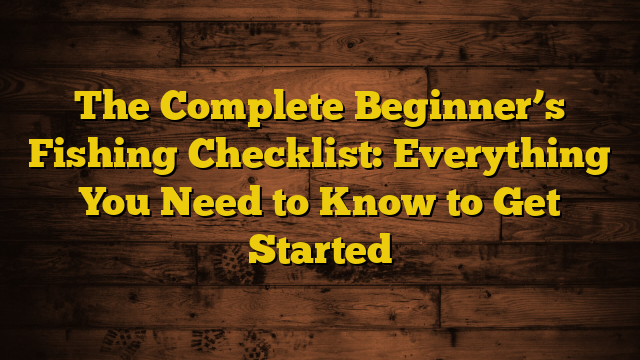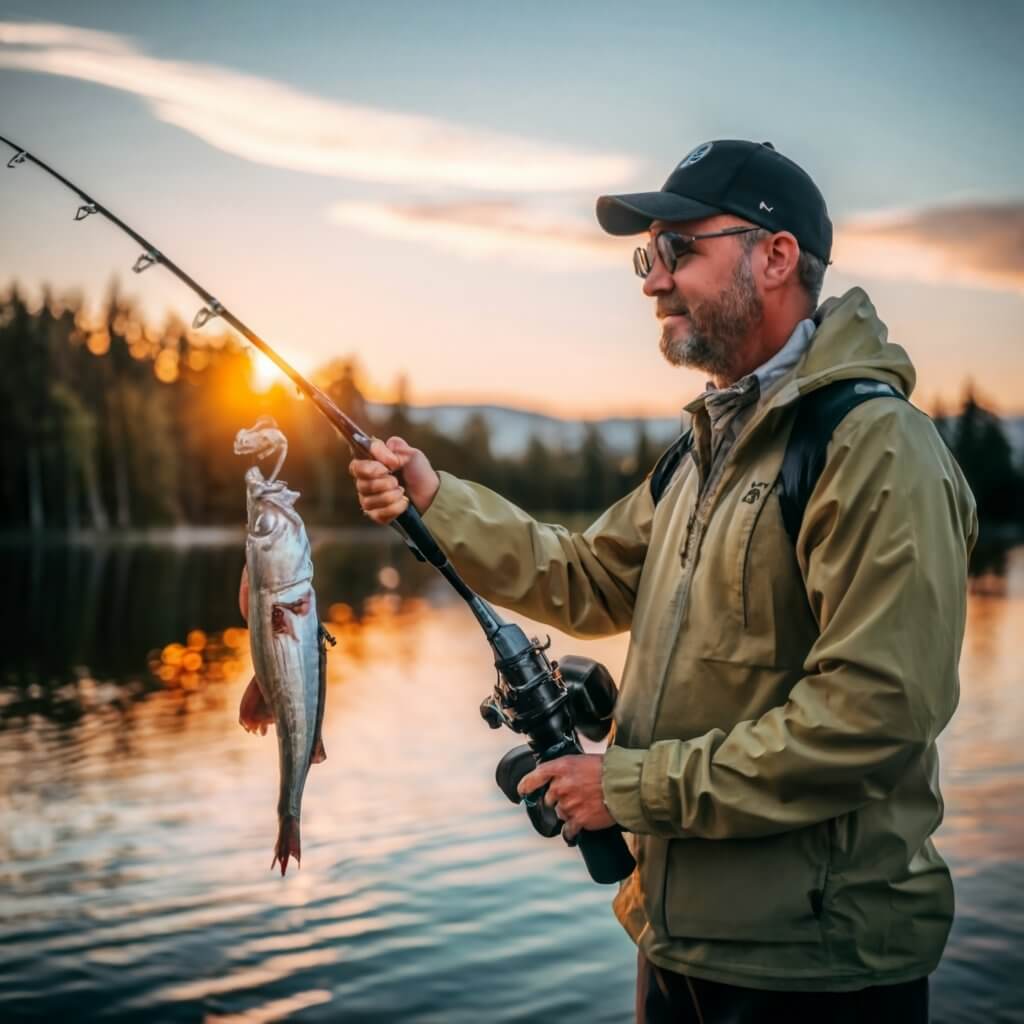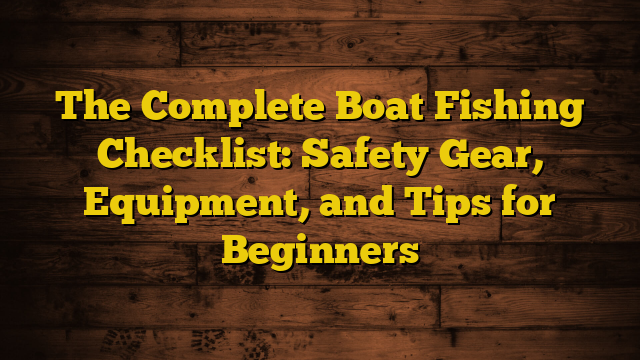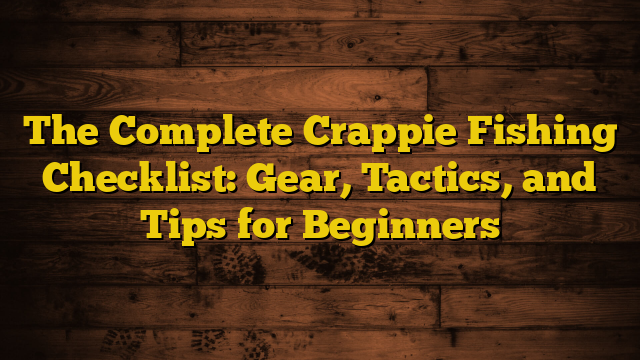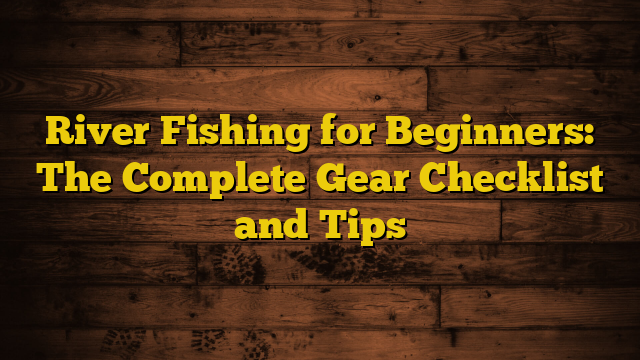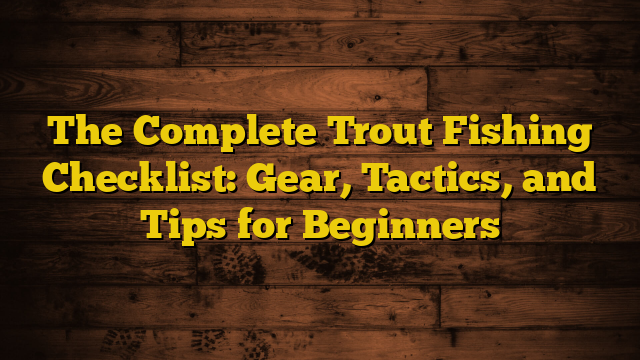Fishing is one of the most enjoyable and rewarding hobbies that can be picked up by anyone, including complete beginners. Whether you want to relax by the lake on a sunny day or catch dinner for the family, grabbing a rod and reel can lead to a lifetime of fun.
This comprehensive guide will provide you with everything you need to get started as a beginner angler. We’ll cover all the essential fishing gear, tips and techniques, choosing a good spot, and additional resources to set you up for success. With this handy checklist, you’ll be reeling in fish in no time!
Why Try Fishing as a Beginner?
Before jumping into the world of fishing, it helps to understand why it’s such a popular hobby – especially for first-timers. Here are some of the great benefits fishing offers:
Get Outside and Explore Nature – Fishing provides the perfect motivation to get outside surrounded by beautiful scenery and fresh air. It connects you with the lakes, rivers, and oceans that harbor fish.
Low Cost of Entry – With basic gear, fishing is an affordable hobby to get started. No need for expensive clubs or equipment. Just grab a rod and find a spot!
Patience and Focus – Casting your line over and over teaches patience and focused attention, almost like an active meditation.
Family Fun – Fishing trips build memories together. It’s a hobby the whole family can enjoy.
Self-Reliance – Anglers gain confidence mastering the sport on their own through trial and error. Success depends on skill.
Health Benefits – Fishing provides great low-impact exercise while reducing stress levels.
For all these reasons, fishing is the perfect hobby for beginners who want to relax, enjoy nature, bond with others, and challenge themselves with new skills – all at an affordable price.
Beginner Fishing Gear Essentials
Having the right fishing gear is crucial for any angler, especially those just getting started. With too little or the wrong equipment, a fishing trip can quickly go from fun to frustrating.
Here are the basic equipment and tackle necessities every beginner will need:
Rod and Reel Combo
This rod and reel combo is the fundamental tool for any angler. As a beginner, you’ll want a versatile and affordable setup made for either baitcasting or spinning styles. Look for a 6-7 foot medium power moderate action rod paired with a reel that holds 200+ yards of 10-12 pound test fishing line. This allows you to catch a variety of panfish, trout, bass, catfish and other common freshwater species.
Don’t invest in an expensive pro-level combo yet. A dependable mid-range setup for ~$70-$100 will handle most beginner needs. Buy from reputable fishing brands like UglyStik, Shimano, or Okuma. Read reviews and get recommendations from experienced anglers.
Fishing Line
Fishing line is what connects your hook or lure to the reel. For many beginners, monofilament line is a good all-purpose choice. It’s affordable, easy to use, and suitable for most species.
The “pound test” you’ll see on line indicates the line strength and thickness. A 10-12 lb test monofilament is appropriate for most freshwater setups using medium power rods. Heavy line on light rods reduces casting distance and accuracy. Light line on heavy rods risks breaking on hooksets and fighting fish. Match the line strength to your gear.
Stock up on various colors like clear, green, yellow, and red. This helps line stand out in different water conditions. Keep extra line spools in your tackle box in case your line snaps or gets worn.
Lures and Bait
You can fish with either artificial lures or live bait. Artificial lures include hard baits like crankbaits, spoons, spinners, and jigs made of metal or plastic. Soft plastic lures are also productive for species like bass and trout. Having a tackle box stocked with a variety of lures allows you to experiment to see what’s working.
Live bait like worms, minnows, shrimp, and cut bait can also be very effective when targeting different fish species. Keep these alive in an aerated bucket or cooler. Local bait shops sell productive regional live baits.
Both lures and bait produce fish. Stock up on a range of both artificial and live options to figure out your go-to’s through trial and error on the water.
Terminal Tackle
Terminal tackle connects your line to hooks, lures and bait. Useful terminal tackle includes:
- Fishing hooks – Single, treble, and double hooks in a range of sizes for different baits.
- Bobbers – Plastic floats that suspend bait at a fixed depth.
- Sinker weights – Add casting weight and sink baits down to fish.
- Swivels – Used to prevent line twist and separation when casting.
- Leaders – Attached between main line and lure to prevent break-offs.
- Lure clips – Allows lures to be changed out quickly.
This terminal tackle attaches your gear to the end of the line and helps present it. Carry a variety in your tackle box.
Fishing Tools and Accessories
Specialized fishing tools and accessories help any angler fish smarter:
- Pliers – Helps safely unhook fish and remove swallowed hooks.
- Knife – Cuts fishing line and preps baitfish. Look for stainless steel.
- Tackle boxes – Keeps all lures, tools, and tackle neatly organized.
- Cooler – Once caught, fish remain fresh on ice. Hard or soft-sided.
- Tape measure – Determines legal size and tracks personal best catches.
- Scale – Weigh your monster catches for bragging rights!
- Stringer – Keeps your catch alive and fresh in the water.
- Camera – Capture memories of trophy fish or scenic spots.
- Polarized sunglasses – Cuts glare allowing you to see below the surface.
- Waders or boots – Keeps you dry when wading or on shore. Neoprene or rubber.
- Sunscreen and hat – Prevent sunburn on long days outside.
- Hip/waist tackle bags – Comfortably carry gear and tackle.
This collection of tools and accessories helps anglers handle everything from boats to bait. Build your supply over time as needs arise.
Additional Beginner Fishing Supplies
To maximize your time on the water, be sure to also have these supplies handy:
- Fishing license – Required for anglers over 16 in most regions. Buy annual or daily licenses online or from tackle shops.
- First aid kit – Hook wounds, slip hazards, and cuts can happen. Bandages, gauze, disinfectant treat these minor issues.
- Food and water – Fishing requires patience and waiting for bites. Stay energized and hydrated with snacks and bottles of water.
- Sun protection – Hats, sunglasses, UPF shirts, and waterproof sunscreen guard against sun overexposure.
- Multitool – Pliers, knife, scissors in one tool. Useful for making gear repairs lakeside.
- Headlamp/flashlight – For early morning or night fishing trips. Also aids in tying knots or changing lures.
- Insect repellent – Bug sprays and lotions keep pesky insects from ruining your trip.
- Camera – Capture memories of your catch or the beautiful places fishing takes you. Smartphones work well.
- Towels – Dry your hands off after baiting up. Also use to wipe down gear or wet fishing spots before sitting.
- Trash bags – Responsible anglers clean up trash left behind by less considerate people.
Beginner Fishing Tips and Techniques
With all the proper gear selected, you can get started learning fundamental fishing skills:
Setting Up Your Rod
- Attach reel to rod and tighten securely
- Thread fishing line through the rod guides
- Tie line to reel using improved clinch knot
- Clip on a lure or tie on a hook
Baiting Your Hook
- For live bait, thread worm, minnow, shrimp etc onto the hook
- Twist bait to conceal the hook inside
- Keep bait hooked through both ends to secure it
Casting Your Line
- Face your target on the water
- Bring rod backwards, then quickly forward to launch lure/bait
- Let go of reel button mid-swing to release line
- Stop rod once bait hits the water
Setting the Hook
- Once you feel a strike or bite, quickly tug up on the rod firmly
- Sets the hook into mouth of the fish before it releases the bait
- Don’t pause – immediately set hook on any nibble or bump
Fighting and Reeling In Fish
- Keep rod tip up and reel handle cranking once hook is set
- Let the rod absorb force of fish pulls – don’t reel during runs
- Move rod down and up to get fish closer to you
- Hand-over-hand reeling motion until fish is boatside or at shore
Landing Fish
- Use a net to scoop the fish up and out of the water
- Or grip carefully with wet hands if fish is small enough
- Don’t let fish flop around on shore/dock – unhook quickly
Releasing Fish
- Use pliers to remove hook if swallowed past the fish’s mouth
- Handle fish gently without squeezing organs
- Revive fish by moving it slowly back and forth in water
- Let go once it swims strongly out of your hands
Other Key Skills
- Knot tying – Essential knots like improved clinch, palomar, and uni knots.
- Rigging – Connecting hooks, lures, bobbers, weights to your line properly.
- Casting accuracy – Placing lures precisely where fish are holding.
- Reading water – Identifying fishy spots based on depth, cover, and structure.
Practice these fundamental techniques regularly to develop your skills. Patience and persistence are key!
Choosing a Good Beginner Fishing Spot
Where you choose to cast your line is just as important as having the right gear and tackle. As a beginner, focus on finding beginner-friendly fishing locations such as:
Ponds
Small ponds offer ideal conditions to practice casting and shore fishing. Look for ponds stocked with popular panfish like crappie, bluegill, and perch. Largemouth bass also thrive in weedy ponds. Fish near lily pads, submerged logs, or other cover that attracts baitfish.
Lakes
Lakes provide ample shoreline access points and shallow coves perfect for new anglers. Target bass hugging docks or cruising the flats. Fish from shore, piers, or boats if possible. Don’t overlook trout in the cold depths of deep lakes.
Rivers and Streams
Wade in and cast from smaller rivers and streams. Trout eagerly bite in faster moving riffles and pools. Larger rivers have channels, tributaries and backwaters holding bass, walleye, and catfish. Shore fishing allows you to sample everything.
Chartered Fishing Trips
Want to catch ocean fish or need a captain to do the work? Chartered fishing trips put you on stocked lakes or optimal coastal spots. Ask questions and learn from the pro guides. All you need to do is reel in fish!
Local Parks
Community parks often stock small ponds with catfish, trout, and bass for public recreational fishing. These are ideal for parents with kids looking to catch their first fish just minutes from home.
Ask fellow anglers for their favorite beginner-friendly honey holes. Check websites and fishing forums covering your local region. Do scouting to find locations not overrun with dense weeds, snags or thick cover. Finding the fish is part of the fun!
Must-Have Beginner Fishing Resources
To accelerate your learning, take advantage of these invaluable fishing resources:
Local Fishing Groups
Join a local fishing club or online community like forums and social media groups. Learning first-hand from seasoned anglers in your area can fast track success. Groups post tips, organize group trips, and often host free beginner classes and events.
Fishing Classes
Adult education providers, bait and tackle shops, community colleges, and recreation centers frequently offer introductory hands-on fishing courses. Learn skills like casting, rigging, knot tying, fish finding, filleting and more in a structured environment.
YouTube Channels
The abundance of fishing content on YouTube makes learning visual-based skills easy. How-to videos demonstrate proper techniques for everything from choosing lures to cleaning fish once caught. Binge watch during the off-season!
Websites
State wildlife agency sites share local fishing regulations, lake data, stocking schedules, and permit info. TakeMeFishing.org provides a wealth of beginner articles and tips. Sites like FishandGame.com give advice on tackle, gear, and tactics.
Magazines and Books
Numerous magazines like Field and Stream and books cater specifically to enlightening anglers of all experience levels with their how-to fishing knowledge. Check your local library for volumes covering your target species and region.
Social Media
Facebook groups, Reddit, and forums like r/FishingForBeginners allow you to pick the brain of the online fishing community. Ask questions, post pictures of catches, and discuss gear and tactics.
Don’t be afraid to engage experts around you! Seasoned anglers love to pass on hard-won knowledge and tips to newcomers. Tap this friendly community of mentors to help you get hooked on fishing.
Family Fishing Fun for Beginners
Fishing is one of the best family activities because it appeals to all ages, gets you outside together, and teaches patience and discovery. Follow these tips to make family fishing trips fun:
- Start kids out with basic push-button spin cast rods and kid-friendly bobber and worm rigs. Upgrade gear as they progress.
- Pack snacks, games, kites and other entertainment for when fish aren’t biting. Short attention spans need engaging.
- Mix in other activities like hiking, bird watching, picnicking, or swimming to keep the day fun.
- Take photos of catches to look back on. Create a journal or scrapbook recording new species caught and fun memories made.
- Be patient and let kids learn at their own pace. Make it more about the experience than catching fish.
- Teach kids to carefully handle fish, respect nature, and practice catch and release fishing. Instill ethical habits.
- Above all, focus on creating laughter and adventure. Foster curiosity in nature. Fish are just a bonus!
With the right attitude, equipment, and spot, a day spent fishing with family becomes a special bonding experience that instills a lifelong love of the outdoors.
Quick Pre-Trip Fishing Checklist
Before heading out on any fishing adventure, experienced anglers run through this mental checklist:
- Rods/reels strung and rigged properly
- Tackle box fully stocked with fresh line, lures, tools
- Cooler loaded with ice, water, drinks
- Livewell or bucket aerated for bait
- Licenses and permits up to date
- Weather forecast – safe conditions
- Sun protection (hat, shades, sunscreen)
- First aid kit fully stocked
- Camera or phone protected in dry bag
- Headlamp if fishing early/late
- Know target fish species and productive tactics
Double checking gear prevents frustration from forgotten equipment or supplies. Load up the night before and hit the water at first light!
Conclusion: Get Started with Smart Fishing as a Beginner
With this comprehensive fishing checklist, you now have all the gear, knowledge, and tips needed to get started fishing successfully as a beginner.
Fishing offers fun, food, and excitement for anglers of all ages while getting you outdoors breathing fresh air. Grab your rod, find a honey hole brimming with fish, and start making memories to last a lifetime.
Remember to exercise patience as a beginner and persistence through the learning curve. Set small goals like learning knots or having a fish on for 1 minute. Gain skills incrementally with each trip. Ask for help from the friendly fishing community around you.
Soon enough, you’ll have mastered the sport enough to pay the knowledge forward by mentoring other newbies. That’s the true spirit of fishing – adventuring together as one community in search of the next big catch.
So don’t wait another second! Follow this Beginner’s Fishing Checklist and let the reel fun begin!

